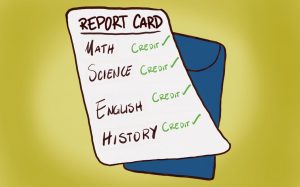PRO: Pros and cons of the new credit/ no credit system
April 23, 2020
The Santa Clara Unified School District has decided to adopt a credit/no credit grading system for grades six-12 for the remainder of the 2019-2020 school year. This decision, announced in Superintendent Stella Kemp’s weekly update on April 18, is not entirely a surprise. Many high school and university campuses in California have made this change, which is not only beneficial but essential for those who have been greatly impacted by the COVID-19 pandemic.
The primary purpose of adopting credit/no credit is to ease the stress and rigor of school so that more effort can be focused on slowing the spread of the coronavirus. It also creates equity and flexibility during a pandemic where social and economic divides have come into harsher focus. The fact is, grades are not a priority for many students and families struggling to find food, shelter, childcare and access to COVID-19 tests. Many parents do not have the luxury of staying at home because they are healthcare professionals or essential workers. Others have lost their jobs and have no income. According to the New York Times, 26 million people have filed jobless claims in the U.S. in five weeks. Compared to these stressors, grades should not be another factor.
Online learning itself is difficult for many students and teachers. Wifi connection is often weak and unreliable, and while SCUSD students are fortunate to have school-issued devices, many districts not in the heart of Silicon Valley cannot afford it. Even with a reliable device and Wifi, many students do not have a desk or quiet space to work at home. Tuning out the background noise to keep up with the constant influx of graded assignments would have a negative impact on students’ letter grades.
Furthermore, many colleges, including the University of California and California State University systems have adopted credit/no credit and have stated that high school students will not be penalized. While many students are concerned that credit/no credit will harm their chances of admission to their preferred university, the system has been disrupted enough that creating some uniformity in the form of credit/no credit is justified. The decision at SCUSD follows the lead of many other California high schools, and it is better than the idea proposed by the San Francisco Board of Education to give out As to all of its students. While a nice sentiment, all As would call into doubt every San Francisco student during college admissions.
The credit/no credit system does rob high-achieving students of the As and Bs reflecting their effort in the third quarter. However, it is necessary to create equity. At SCHS, students cannot receive a lower grade than the one they had when school closed as part of the “hold harmless” policy. Therefore, it is arguable that a student who was passing might simply decide to stop turning in assignments. However, one must take into account the work ethic that is ingrained in many high-achieving students. Most straight-A students will not just stop completing their work – they will continue to learn, albeit halfheartedly.
Credit/no credit is by no means a long-term solution. It is merely a way to reduce stress and allow flexibility while schools consider the next step. Considering the situation, a breather should be welcome, and universities have promised it will not harm students’ chances of admission.


